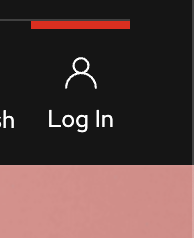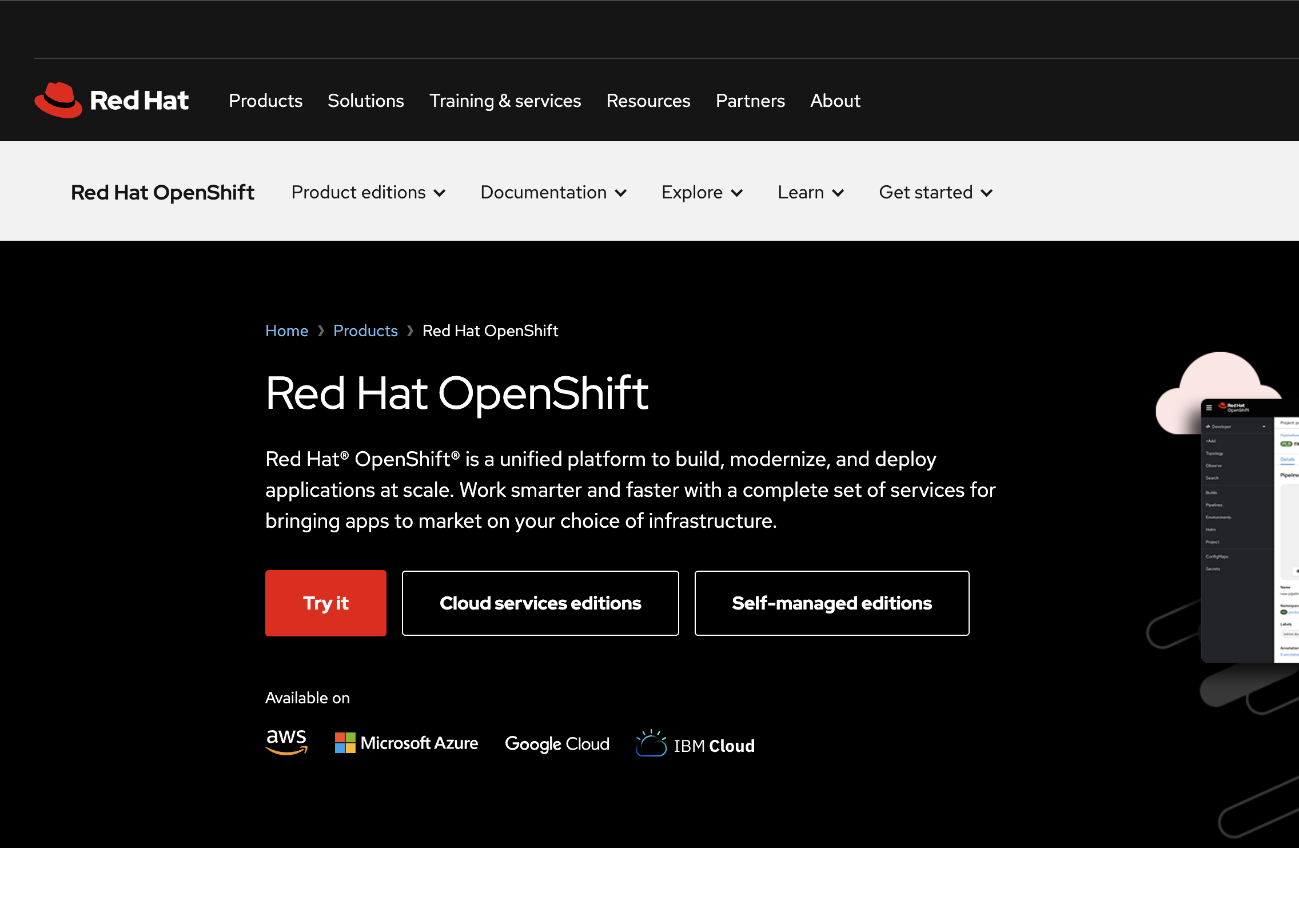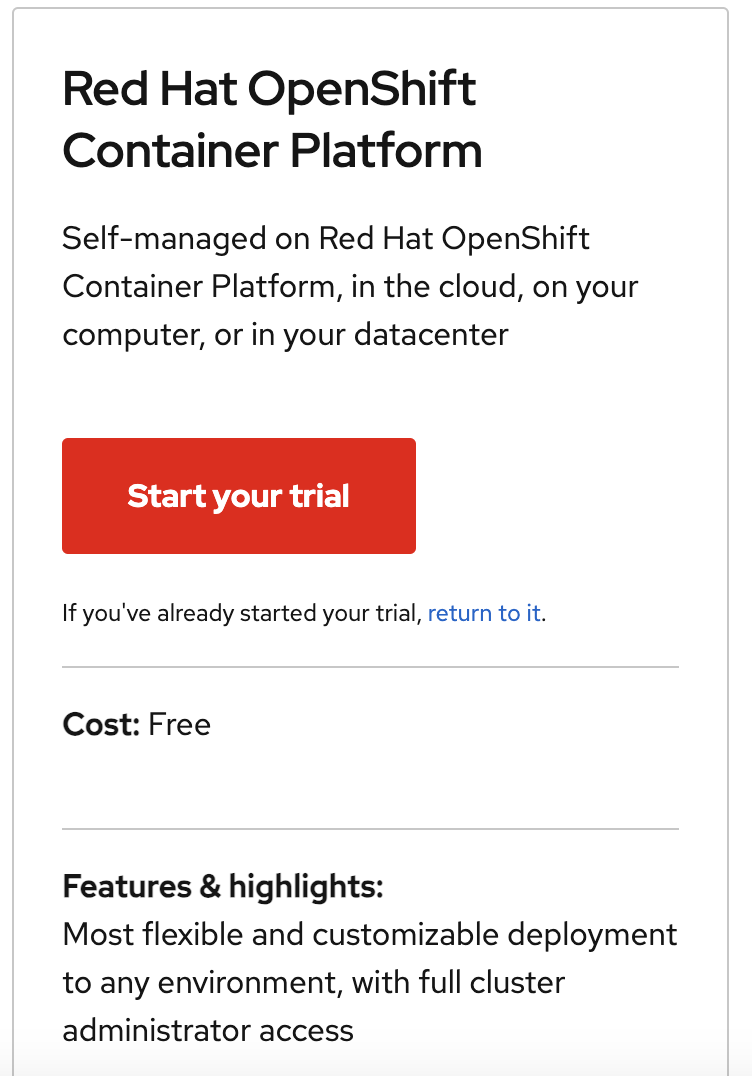Prerequisites
Installing OpenShift and Cloud Pak for Data requires specific access, resources and considerations on AWS. In this documentation, we are assuming a CloudFormation install on user-provisioned infrastructure.
RedHat Requirements
RedHat OCP Account and Pull Secret
This is the required account used for the OCP licensing. Use this URL to download your RedHat Pull Secret: https://console.redhat.com/openshift/install/pull-secret
If your organization does not own an OCP license, a trial license can be used for OCP and is valid for 60 days. Steps listed in the expandable section below.
Obtain a RedHat Trial Account
Go to www.redhat.com and click on "Log In".

Then click on "Register for a Red Hat Account".

Provide the requested information and "Create Account".
You will receive a verification email. Click on the link in the email to confirm.
Now go to www.openshift.com and log in with your RedHat account. After logging in you will see this:

Click on "Try It" which will bring you to a page of different OpenShift versions to try, find the following version and click "Start your Trial":

A new page will load and you will need to enter all the required information before clicking "Submit".
You can now log into https://console.redhat.com/openshift/install/pull-secret and download the pull-secret.
IBM Requirements
CP4D and watsonx.ai are part of IBM's entitled software program. In order to download and install it you will need your IBM entitlement key which can be retrieved here.
You will need your valid IBM id in order to login.
AWS Requirements
IAM User Requirements
If deploying using an IAM user, below are the requirements, roles, and steps.
Each Amazon Web Services (AWS) account contains a root user account that is based on the email address you used to create the account. This is a highly-privileged account, and it is recommended to use it for only initial account and billing configuration, creating an initial set of users, and securing the account. Before you install OpenShift Container Platform, create a secondary IAM administrative user. As you complete the Creating an IAM User in Your AWS Account procedure in the AWS documentation, set the following options:
-
Specify the IAM user name and select Programmatic access.
-
Attach the AdministratorAccess policy to ensure that the account has sufficient permission to create the cluster. This policy provides the cluster with the ability to grant credentials to each OpenShift Container Platform component. The cluster grants the components only the credentials that they require.
While it is possible to create a policy that grants the all of the required AWS permissions and attach it to the user, this is not the preferred option. The cluster will not have the ability to grant additional credentials to individual components, so the same credentials are used by all components.
-
Optional: Add metadata to the user by attaching tags.
-
Confirm that the user name that you specified is granted the AdministratorAccess policy.
-
Record the access key ID and secret access key values. You must use these values when you configure your local machine to run the installation program.
You cannot use a temporary session token that you generated while using a multi-factor authentication device to authenticate to AWS when you deploy a cluster. The cluster continues to use your current AWS credentials to create AWS resources for the entire life of the cluster, so you must use key-based, long-term credentials.
Your IAM user must have the permission tag:GetResources in the region us-east-1 to delete the base cluster resources. As part of the AWS API requirement, the OpenShift Container Platform installation program performs various actions in this region.
When you attach the AdministratorAccess policy to the IAM user that you create in Amazon Web Services (AWS), you grant that user all of the required permissions.
To deploy all components of an OpenShift Container Platform cluster, the IAM user requires the following permissions:
Required Permissions (if not using Administrator Access)
Required EC2 permissions for installation
ec2:AuthorizeSecurityGroupEgress
ec2:AuthorizeSecurityGroupIngress
ec2:CopyImage
ec2:CreateNetworkInterface
ec2:AttachNetworkInterface
ec2:CreateSecurityGroup
ec2:CreateTags
ec2:CreateVolume
ec2:DeleteSecurityGroup
ec2:DeleteSnapshot
ec2:DeleteTags
ec2:DeregisterImage
ec2:DescribeAccountAttributes
ec2:DescribeAddresses
ec2:DescribeAvailabilityZones
ec2:DescribeDhcpOptions
ec2:DescribeImages
ec2:DescribeInstanceAttribute
ec2:DescribeInstanceCreditSpecifications
ec2:DescribeInstances
ec2:DescribeInstanceTypes
ec2:DescribeInternetGateways
ec2:DescribeKeyPairs
ec2:DescribeNatGateways
ec2:DescribeNetworkAcls
ec2:DescribeNetworkInterfaces
ec2:DescribePrefixLists
ec2:DescribeRegions
ec2:DescribeRouteTables
ec2:DescribeSecurityGroups
ec2:DescribeSubnets
ec2:DescribeTags
ec2:DescribeVolumes
ec2:DescribeVpcAttribute
ec2:DescribeVpcClassicLink
ec2:DescribeVpcClassicLinkDnsSupport
ec2:DescribeVpcEndpoints
ec2:DescribeVpcs
ec2:GetEbsDefaultKmsKeyId
ec2:ModifyInstanceAttribute
ec2:ModifyNetworkInterfaceAttribute
ec2:RevokeSecurityGroupEgress
ec2:RevokeSecurityGroupIngress
ec2:RunInstances
ec2:TerminateInstances
Required permissions for creating network resources during installation
ec2:AllocateAddress
ec2:AssociateAddress
ec2:AssociateDhcpOptions
ec2:AssociateRouteTable
ec2:AttachInternetGateway
ec2:CreateDhcpOptions
ec2:CreateInternetGateway
ec2:CreateNatGateway
ec2:CreateRoute
ec2:CreateRouteTable
ec2:CreateSubnet
ec2:CreateVpc
ec2:CreateVpcEndpoint
ec2:ModifySubnetAttribute
ec2:ModifyVpcAttribute
If you use an existing VPC, your account does not require these permissions for creating network resources.
Required Elastic Load Balancing permissions (ELB) for installation
elasticloadbalancing:AddTags
elasticloadbalancing:ApplySecurityGroupsToLoadBalancer
elasticloadbalancing:AttachLoadBalancerToSubnets
elasticloadbalancing:ConfigureHealthCheck
elasticloadbalancing:CreateLoadBalancer
elasticloadbalancing:CreateLoadBalancerListeners
elasticloadbalancing:DeleteLoadBalancer
elasticloadbalancing:DeregisterInstancesFromLoadBalancer
elasticloadbalancing:DescribeInstanceHealth
elasticloadbalancing:DescribeLoadBalancerAttributes
elasticloadbalancing:DescribeLoadBalancers
elasticloadbalancing:DescribeTags
elasticloadbalancing:ModifyLoadBalancerAttributes
elasticloadbalancing:RegisterInstancesWithLoadBalancer
elasticloadbalancing:SetLoadBalancerPoliciesOfListener
Required Elastic Load Balancing permissions (ELBv2) for installation
elasticloadbalancing:AddTags
elasticloadbalancing:CreateListener
elasticloadbalancing:CreateLoadBalancer
elasticloadbalancing:CreateTargetGroup
elasticloadbalancing:DeleteLoadBalancer
elasticloadbalancing:DeregisterTargets
elasticloadbalancing:DescribeListeners
elasticloadbalancing:DescribeLoadBalancerAttributes
elasticloadbalancing:DescribeLoadBalancers
elasticloadbalancing:DescribeTargetGroupAttributes
elasticloadbalancing:DescribeTargetHealth
elasticloadbalancing:ModifyLoadBalancerAttributes
elasticloadbalancing:ModifyTargetGroup
elasticloadbalancing:ModifyTargetGroupAttributes
elasticloadbalancing:RegisterTargets
Required IAM permissions for installation
iam:AddRoleToInstanceProfile
iam:CreateInstanceProfile
iam:CreateRole
iam:DeleteInstanceProfile
iam:DeleteRole
iam:DeleteRolePolicy
iam:GetInstanceProfile
iam:GetRole
iam:GetRolePolicy
iam:GetUser
iam:ListInstanceProfilesForRole
iam:ListRoles
iam:ListUsers
iam:PassRole
iam:PutRolePolicy
iam:RemoveRoleFromInstanceProfile
iam:SimulatePrincipalPolicy
iam:TagRole
If you have not created a load balancer in your AWS account, the IAM user also requires the iam:CreateServiceLinkedRole permission.
Required Route 53 permissions for installation
route53:ChangeResourceRecordSets
route53:ChangeTagsForResource
route53:CreateHostedZone
route53:DeleteHostedZone
route53:GetChange
route53:GetHostedZone
route53:ListHostedZones
route53:ListHostedZonesByName
route53:ListResourceRecordSets
route53:ListTagsForResource
route53:UpdateHostedZoneComment
Required S3 permissions for installation
s3:CreateBucket
s3:DeleteBucket
s3:GetAccelerateConfiguration
s3:GetBucketAcl
s3:GetBucketCors
s3:GetBucketLocation
s3:GetBucketLogging
s3:GetBucketPolicy
s3:GetBucketObjectLockConfiguration
s3:GetBucketRequestPayment
s3:GetBucketTagging
s3:GetBucketVersioning
s3:GetBucketWebsite
s3:GetEncryptionConfiguration
s3:GetLifecycleConfiguration
s3:GetReplicationConfiguration
s3:ListBucket
s3:PutBucketAcl
s3:PutBucketTagging
s3:PutEncryptionConfiguration
S3 permissions that cluster Operators required
s3:DeleteObject
s3:GetObject
s3:GetObjectAcl
s3:GetObjectTagging
s3:GetObjectVersion
s3:PutObject
s3:PutObjectAcl
s3:PutObjectTagging
Required permissions to delete base cluster resources
autoscaling:DescribeAutoScalingGroups
ec2:DeletePlacementGroup
ec2:DeleteNetworkInterface
ec2:DeleteVolume
elasticloadbalancing:DeleteTargetGroup
elasticloadbalancing:DescribeTargetGroups
iam:DeleteAccessKey
iam:DeleteUser
iam:ListAttachedRolePolicies
iam:ListInstanceProfiles
iam:ListRolePolicies
iam:ListUserPolicies
s3:DeleteObject
s3:ListBucketVersions
tag:GetResources
Required permissions to delete network resources
ec2:DeleteDhcpOptions
ec2:DeleteInternetGateway
ec2:DeleteNatGateway
ec2:DeleteRoute
ec2:DeleteRouteTable
ec2:DeleteSubnet
ec2:DeleteVpc
ec2:DeleteVpcEndpoints
ec2:DetachInternetGateway
ec2:DisassociateRouteTable
ec2:ReleaseAddress
ec2:ReplaceRouteTableAssociation
If you use an existing VPC, your account does not require these permissions to delete network resources. Instead, your account only requires the tag:UntagResources permission to delete network resources.
Required permissions to delete a cluster with shared instance roles
iam:UntagRole
Additional IAM and S3 permissions that are required to create manifests
iam:DeleteAccessKey
iam:DeleteUser
iam:DeleteUserPolicy
iam:GetUserPolicy
iam:ListAccessKeys
iam:PutUserPolicy
iam:TagUser
s3:PutBucketPublicAccessBlock
s3:GetBucketPublicAccessBlock
s3:PutLifecycleConfiguration
s3:HeadBucket
s3:ListBucketMultipartUploads
s3:AbortMultipartUpload
If you are managing your cloud provider credentials with mint mode, the IAM user also requires the iam:CreateAccessKey and iam:CreateUser permissions.
Optional permissions for instance and quota checks for installation
ec2:DescribeInstanceTypeOfferings
servicequotas:ListAWSDefaultServiceQuotas
Optional permissions for the cluster owner account when installing a cluster on a shared VPC
sts:AssumeRole
For more details on the IAM user requirements, see https://docs.openshift.com/container-platform/4.15/installing/installing_aws/installing-aws-account.html#installing-aws-account
AWS Role Permissions Checker
Bash script that can be run on linux or OS X. Requires AWS CLI to be installed and configured.
Script user will need the following permissions:
- iam:SimulatePrincipalPolicy
- iam:GetPolicy
- iam:GetPolicyVersion
Or run the following commands:
wget /assets/script/check-permissions.sh
chmod +x check-permission.sh
To run the script you will need to download the "permissions.txt" file.
Download permissions.txt
Script Syntax
./check-permissions.sh <ROLE> <PERMISSIONS FILE>
The permissions file is long and will take a few minutes for the script to work through. The output from the script is a file named "missing_permissions.txt".
Required AWS Infrastructure Components
To install OpenShift Container Platform on user-provisioned infrastructure in Amazon Web Services (AWS), you must manually create both the machines and their supporting infrastructure. For more information about the integration testing for different platforms, see the OpenShift Container Platform 4.x Tested Integrations page.
By using the provided CloudFormation templates, you can create stacks of AWS resources that represent the following components:
- An AWS Virtual Private Cloud (VPC)
- Networking and load balancing components
- Security groups and roles
- An OpenShift Container Platform bootstrap node
- OpenShift Container Platform control plane nodes
- An OpenShift Container Platform compute node
Alternatively, you can manually create the components or you can reuse existing infrastructure that meets the cluster requirements. Review the CloudFormation templates for more details about how the components interrelate.
Other infrastructure components:
- A VPC
- DNS entries
- Load balancers (classic or network) and listeners
- A public and a private Route 53 zone
- Security groups
- IAM roles
- S3 buckets
Required VPC Components
You must provide a suitable VPC and subnets that allow communication to your machines:
| Component | AWS type | Description |
|---|---|---|
| VPC | AWS::EC2::VPC AWS::EC2::VPCEndpoint | You must provide a public VPC for the cluster to use. The VPC uses an endpoint that references the route tables for each subnet to improve communication with the registry that is hosted in S3. |
| Public subnets | AWS::EC2::Subnet AWS::EC2::SubnetNetworkAclAssociation | Your VPC must have public subnets for between 1 and 3 availability zones and associate them with appropriate Ingress rules. |
| Internet gateway | AWS::EC2::InternetGateway AWS::EC2::VPCGatewayAttachment AWS::EC2::RouteTable AWS::EC2::Route AWS::EC2::SubnetRouteTableAssociation AWS::EC2::NatGateway AWS::EC2::EIP | You must have a public internet gateway, with public routes, attached to the VPC. In the provided templates, each public subnet has a NAT gateway with an EIP address. These NAT gateways allow cluster resources, like private subnet instances, to reach the internet and are not required for some restricted network or proxy scenarios. |
| Network access control | AWS::EC2::NetworkAcl AWS::EC2::NetworkAclEntry | Required Ports: 80, 443, 22, 1024-65535, 0-65535 |
| Private subnets | AWS::EC2::Subnet AWS::EC2::RouteTable AWS::EC2::SubnetRouteTableAssociation | Your VPC can have private subnets. The provided CloudFormation templates can create private subnets for between 1 and 3 availability zones. If you use private subnets, you must provide appropriate routes and tables for them. |
Required DNS and load balancing components
Your DNS and load balancer configuration needs to use a public hosted zone and can use a private hosted zone similar to the one that the installation program uses if it provisions the cluster’s infrastructure. You must create a DNS entry that resolves to your load balancer. An entry for api.cluster_name.domain must point to the external load balancer, and an entry for api-int.cluster_name.domain must point to the internal load balancer.
The cluster also requires load balancers and listeners for port 6443, which are required for the Kubernetes API and its extensions, and port 22623, which are required for the Ignition config files for new machines. The targets will be the control plane nodes. Port 6443 must be accessible to both clients external to the cluster and nodes within the cluster. Port 22623 must be accessible to nodes within the cluster.
| Component | AWS type | Description |
|---|---|---|
| DNS | AWS::Route53::HostedZone | The hosted zone for your internal DNS. |
| Public load balancer | AWS::ElasticLoadBalancingV2::LoadBalancer | The load balancer for your public subnets. |
| External API server record | AWS::Route53::RecordSetGroup | Alias records for the external API server. |
| External listener | AWS::ElasticLoadBalancingV2::Listener | A listener on port 6443 for the external load balancer. |
| External target group | AWS::ElasticLoadBalancingV2::TargetGroup | The target group for the external load balancer. |
| Private load balancer | AWS::ElasticLoadBalancingV2::LoadBalancer | The load balancer for your private subnets. |
| Internal API server record | AWS::Route53::RecordSetGroup | Alias records for the internal API server. |
| Internal listener | AWS::ElasticLoadBalancingV2::Listener | A listener on port 22623 for the internal load balancer. |
| Internal target group | AWS::ElasticLoadBalancingV2::TargetGroup | The target group for the internal load balancer. |
| Internal listener | AWS::ElasticLoadBalancingV2::Listener | A listener on port 6443 for the internal load balancer. |
| Internal target group | AWS::ElasticLoadBalancingV2::TargetGroup | The target group for the internal load balancer. |
Required Security groups
The control plane and worker machines require access to the following ports:
| Group | Type | IP Protocol | Port range |
|---|---|---|---|
| MasterSecurityGroup | AWS::EC2::SecurityGroup | icmp | 0 |
| tcp | 22 | ||
| tcp | 6443 | ||
| tcp | 22623 | ||
| WorkerSecurityGroup | AWS::EC2::SecurityGroup | icmp | 0 |
| tcp | 22 | ||
| BootstrapSecurityGroup | AWS::EC2::SecurityGroup | tcp | 22 |
| tcp | 19531 |
Control plane Ingress
The control plane machines require the following Ingress groups. Each Ingress group is a AWS::EC2::SecurityGroupIngress resource.
| Group | Type | IP Protocol | Port range |
|---|---|---|---|
| MasterSecurityGroup | AWS::EC2::SecurityGroup | icmp | 0 |
| tcp | 22 | ||
| tcp | 6443 | ||
| tcp | 22623 | ||
| WorkerSecurityGroup | AWS::EC2::SecurityGroup | icmp | 0 |
| tcp | 22 | ||
| BootstrapSecurityGroup | AWS::EC2::SecurityGroup | tcp | 22 |
| tcp | 19531 |
Worker Ingress
The worker machines require the following Ingress groups. Each Ingress group is a AWS::EC2::SecurityGroupIngress resource.
| Group | Type | IP Protocol | Port range |
|---|---|---|---|
| MasterSecurityGroup | AWS::EC2::SecurityGroup | icmp | 0 |
| tcp | 22 | ||
| tcp | 6443 | ||
| tcp | 22623 | ||
| WorkerSecurityGroup | AWS::EC2::SecurityGroup | icmp | 0 |
| tcp | 22 | ||
| BootstrapSecurityGroup | AWS::EC2::SecurityGroup | tcp | 22 |
| tcp | 19531 |
Cluster machines
You need AWS::EC2::Instance objects for the following machines:
- A bootstrap machine. This machine is required during installation, but you can remove it after your cluster deploys.
- Three control plane machines. The control plane machines are not governed by a control plane machine set.
- Compute machines. You must create at least two compute machines, which are also known as worker machines, during installation. These machines are not governed by a compute machine set.
For more information on OCP on AWS, see https://docs.openshift.com/container-platform/4.15/installing/installing_aws/installing-aws-user-infra.html The "Minimum requirements" section does not consider the watsonx.ai and related services, and is accounted for in this documentation
Parameters for CloudFormation Template
The following parameters must be gathered from the AWS infrastructure in order to use the CloudFormation template:
- BootNodeAccessCIDR:
- vpc_id:
- aws_region:
- Example:
us-east-2
- Example:
- machine_cidr:
- Example:
10.2.1.0/24
- Example:
- openshift_cluster_network_cidr:
- Example:
10.128.0.0/14
- Example:
- subnet_ids:
note
For subnets, at least one set of 3 (Public or Private) subnets must be used.
- Public
- Public subnet1
- Public subnet2
- Public subnet3
- Private
- Private subnet1
- Private subnet2
- Private subnet3
- Public
- hosted_zone_id:
- Example:
Hosted_Zone_Id
- Example:
- image_registry:
- name: Registy
- registry_host_name:
- Example:
registry.example.com
- Example:
- registry_port:
- Example:
5000
- Example:
- registry_insecure:
- Example:
false
- Example:
- registry_trusted_ca_secret:
- Example:
cpd463-ca-bundle
- Example:
- http_proxy:
- https_proxy:
- no_proxy:
- KeyPairName:
note
Key Pair generation instructions here
- RedhatPullSecret:
note
RedHat Pull Secret instructions here
- DomainName:
- ClusterName: